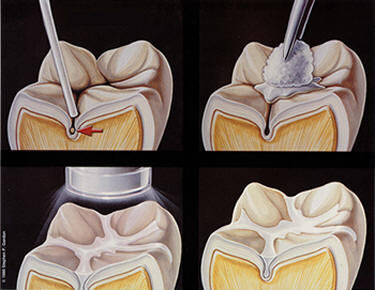Dental Sealants Morgan Hill, CA
What are dental sealants and why does my child need them?
Dental sealants are thin plastic coatings that are applied to the chewing surfaces of the molars (back teeth). Most tooth decay in children and teens occurs in these surfaces.
Sealants cover the chewing surfaces to prevent decay.
Frequently Asked Questions
Permanent molars are the most likely to benefit from sealant applications.
First molars usually come into the mouth when a child is about age 6. Second molars appear at about age 12. It is best if the sealant is applied soon after the molars have erupted, before the teeth have a chance to decay. For that reason, children between the ages of 5 and 15 benefit most from sealants.
However, we encourage sealant application on people of all ages for prevention.
- A dentist or dental hygienist cleans the tooth with special toothpaste.
- A cleansing liquid is rubbed gently on the tooth and washed off.
- The sealant is painted on the tooth. It takes about a minute for the sealant to form a protective shield.
Fluoride works best on the smooth surfaces of teeth. The chewing surfaces on the back teeth, however, have tiny grooves where decay often begins. Sealants keep germs out of the grooves by covering them with a safe plastic coating. Sealants and fluorides work together to prevent tooth decay.
A complete preventive dental program includes use of sealants, fluoride, plaque removal, careful food choices, and regular dental care.
Each time a tooth is filled or a filling is replaced, additional tooth structure is lost.
Fillings last an average of 6 to 8 years before they need to be replaced.
Appropriate use of sealants can save time, money, and the discomfort associated with dental treatment procedures.


